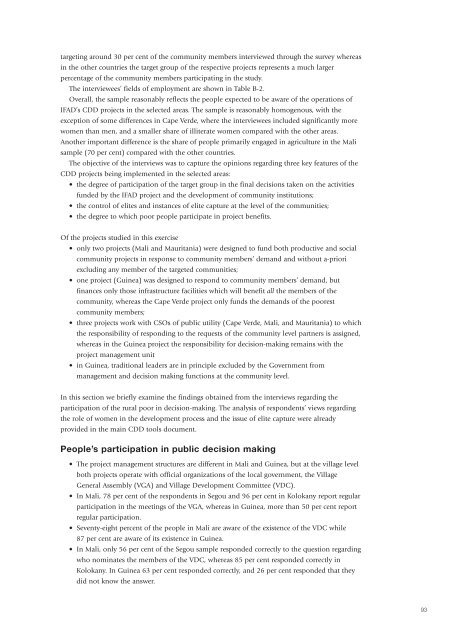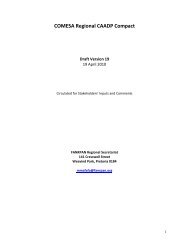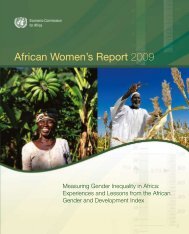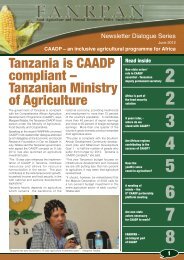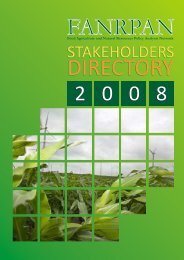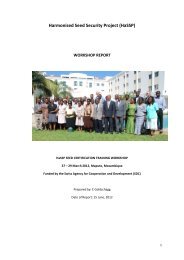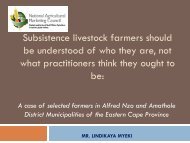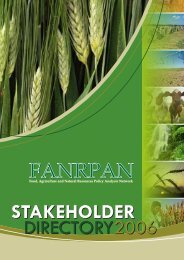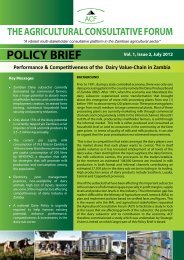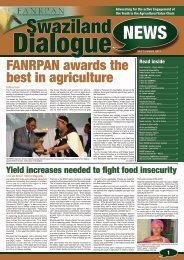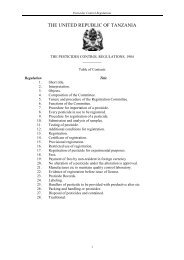targeting around 30 per cent of the community members interviewed through the survey whereasin the other countries the target group of the respective projects represents a much largerpercentage of the community members participating in the study.The interviewees’ fields of employment are shown in Table B-2.Overall, the sample reasonably reflects the people expected to be aware of the operations of<strong>IFAD</strong>’s CDD projects in the selected areas. The sample is reasonably homogenous, with theexception of some differences in Cape Verde, where the interviewees included significantly morewomen than men, and a smaller share of illiterate women compared with the other areas.Another important difference is the share of people primarily engaged in agriculture in the Malisample (70 per cent) compared with the other countries.The objective of the interviews was to capture the opinions regarding three key features of theCDD projects being implemented in the selected areas:• the degree of participation of the target group in the final <strong>decision</strong>s taken on the activitiesfunded by the <strong>IFAD</strong> project and the <strong>development</strong> of community institutions;• the control of elites and instances of elite capture at the level of the communities;• the degree to which poor people participate in project benefits.Of the projects studied in this exercise• only two projects (Mali and Mauritania) were designed to fund both productive and socialcommunity projects in response to community members’ demand and without a-prioriexcluding any member of the targeted communities;• one project (Guinea) was designed to respond to community members’ demand, butfinances only those infrastructure facilities which will benefit all the members of thecommunity, whereas the Cape Verde project only funds the demands of the poorestcommunity members;• three projects work with CSOs of public utility (Cape Verde, Mali, and Mauritania) to whichthe responsibility of responding to the requests of the community level partners is assigned,whereas in the Guinea project the responsibility <strong>for</strong> <strong>decision</strong>-making remains with theproject management unit• in Guinea, traditional leaders are in principle excluded by the Government frommanagement and <strong>decision</strong> making functions at the community level.In this section we briefly examine the findings obtained from the interviews regarding theparticipation of the <strong>rural</strong> poor in <strong>decision</strong>-making. The analysis of respondents’ views regardingthe role of women in the <strong>development</strong> process and the issue of elite capture were alreadyprovided in the main CDD <strong>tools</strong> document.People’s participation in public <strong>decision</strong> making• The project management structures are different in Mali and Guinea, but at the village levelboth projects operate with official organizations of the local government, the VillageGeneral Assembly (VGA) and Village Development Committee (VDC).• In Mali, 78 per cent of the respondents in Segou and 96 per cent in Kolokany report regularparticipation in the meetings of the VGA, whereas in Guinea, more than 50 per cent reportregular participation.• Seventy-eight percent of the people in Mali are aware of the existence of the VDC while87 per cent are aware of its existence in Guinea.• In Mali, only 56 per cent of the Segou sample responded correctly to the question regardingwho nominates the members of the VDC, whereas 85 per cent responded correctly inKolokany. In Guinea 63 per cent responded correctly, and 26 per cent responded that theydid not know the answer.93
• In Segou, 41 per cent of the interviewees thought that members of the VDC are nominatedby the traditional authority, whereas the proportion in Kolokani is as low as 10 per cent.• Only 41 per cent in Segou know the functions of the VDC versus 91 per cent in Kolokany.A question posed to interviewees that gave very different results depending on the area wherethe project was being implemented, asked whether respondents felt that the interests of thecommunity were well represented at the local government levels (i.e. district or prefecture).Eighty-five percent of the interviewees in Segou respond “yes”, whereas in Kolokani only 31 percent are satisfied. In Guinea, two-thirds of the respondents (66 per cent) say that the interests ofthe community are well represented at the higher level, while the rest respond “no”, or “I donot know”.In Mali, the interviews clearly suggest a difference between Segou and Kolokany. In Segou,community members are willing to leave responsibility <strong>for</strong> <strong>decision</strong>s-making over thecommunity affairs to a VDC <strong>for</strong>med by members of the traditional authority, whereas inKolokany people follow the per<strong>for</strong>mance of their VDC much more closely, and are quite criticalof the current relationships with the higher level of the public administration. The situation inGuinea is somewhere in the middle between the two diverging positions identified in Mali.In Mauritania and Cape Verde, legislation enacted during the 1990s clarified the role of theCSOs of public utility with respect to supporting people’s initiatives at community level. Thisenhanced the policy supported by <strong>IFAD</strong>, which promoted a diversification of the institutionsinvolved in local <strong>development</strong> and poverty alleviation at community level. <strong>IFAD</strong> CDD projectsin these two countries were entrusted to CSOs of public utility, representing a significantinnovation in the local governance setting. In both countries, membership to the CSOs wasexpected to include a significant number of the people from the project area, with the aim ofhaving these people becoming the majority in due course.In the two areas investigated in Mauritania, all respondents to the opinion poll knew ofthe existence of the local CSO, with actual membership ranging from 61 per cent of thesample in Adrar to 86 per cent in Assaba. People in<strong>for</strong>med of the objectives and functions ofthe CSOs were 57 per cent and 61 per cent of the sample, respectively, in the two areas. InCape Verde, 75 per cent of the people interviewed knew of the <strong>Community</strong> DevelopmentAssociation (CDA) operating in their village or area. Forty-six per cent of the sample reportedthat they regularly attend regularly the general meetings of the CDA and another 13 per centirregularly. In addition, 70 per cent of the sample declares that women do attend thesemeeting and voice their opinions.In Cape Verde a smaller share of the respondents (34 per cent) declared to be well in<strong>for</strong>medabout the functions and responsibilities of the CDA and about the way the directors of theCDA were nominated. This low result may be the consequence of the fact that only around 30per cent of the random sample were people targeted by the <strong>IFAD</strong> project and members of theCDA that benefited from the project intervention.With respect to questions regarding community based organizations (CBOs) dedicated toproviding private goods <strong>for</strong> the benefit of their members, the main results of the study aregiven in the following box. In Mauritania, the most important CBOs operating in the oases arethe MICOs (local microfinance institutions funded by the <strong>IFAD</strong> project) with 75 per cent ofthe interviewees being a member and 57 per cent of the sample in the Adrar and 61 per cent inthe Assaba being adequately in<strong>for</strong>med of the objectives of the MICOs. Other CBOs (mostlyproduction or service cooperatives, many women’s cooperatives) are also present, but sincethey cannot qualify <strong>for</strong> legal registration, they operate through the local CDA. Other CBOsconcerned with the maintenance of irrigation infrastructure and various water sources alsotend to overlap with the CDAs, in the sense that it is the CDA that maintains the infrastructureand raises the revenue necessary <strong>for</strong> maintenance from the users.94


